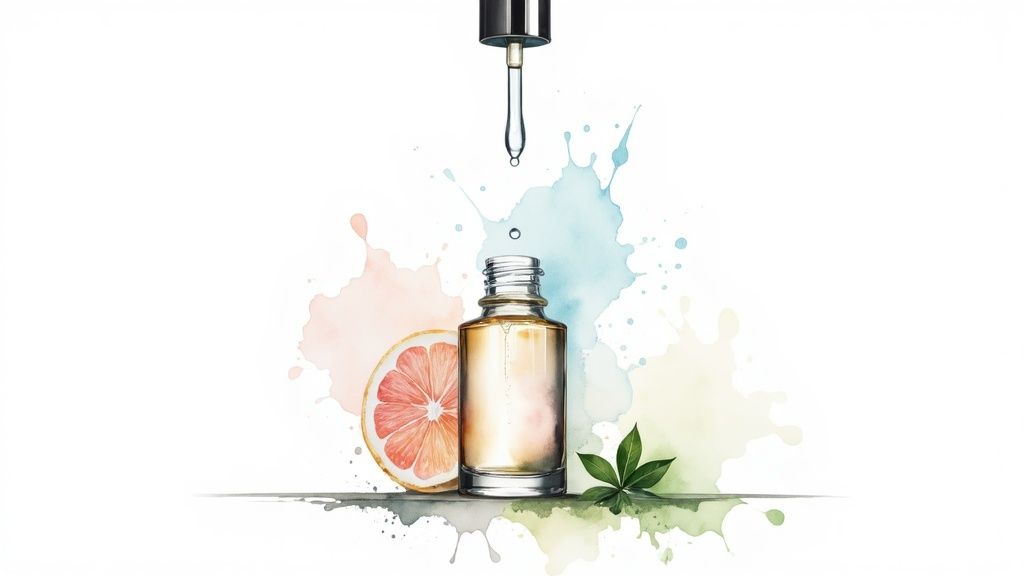
What Are Active Ingredients in Skincare Explained
Ever wonder what makes a skincare product actually work? Think of the ingredient list like a team roster. The active ingredients are your star players—they’re the ones doing the heavy lifting to target specific concerns like breakouts, wrinkles, or dark spots.
These are the powerhouses backed by science, the ingredients that bring about real, visible change in your skin.
The Role of Actives in Your Skincare
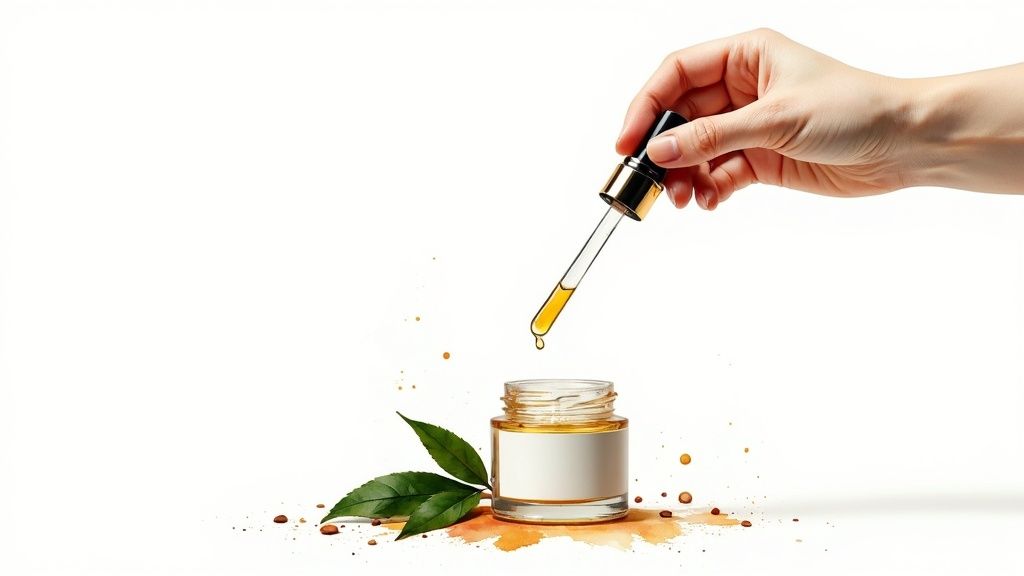
When you scan a product label, you'll see a mix of ingredients. They fall into two camps: active and inactive. While the inactive (or functional) ingredients are essential for the product's texture and stability, the active ingredients are the reason you're buying it.
It’s a bit like building a house. The inactive ingredients are the foundation and walls—they create the structure and make it feel nice. But the active ingredients? They’re the plumbing and electrical systems. They’re what make the house actually do something.
In skincare, "active" simply means the ingredient has a direct, biological effect on the skin. It's been scientifically studied and proven to create a specific change. This is the fundamental difference between a basic moisturizer and a potent anti-aging serum.
Why This Distinction Matters
Learning to spot the active ingredients in your skincare is a game-changer. It helps you cut through the marketing fluff and become a truly savvy consumer. Instead of falling for vague promises, you can seek out products with the specific actives known to work for your goals.
For instance, if you're trying to fade stubborn dark spots, you'll know to look for an active like Vitamin C or azelaic acid on the label.
This knowledge also empowers you to build a routine that’s both effective and safe. Actives are potent, so they need to be handled with care. Mixing the wrong ones can cause some serious irritation, but using them correctly can deliver incredible results.
To help you get started, here's a quick look at some of the most common active ingredients and what they're famous for.
Quick Guide to Common Skincare Actives
This table breaks down the main categories of actives and the skin concerns they're best at tackling.
| Active Category | Primary Function | Best For |
|---|---|---|
| Retinoids | Increases cell turnover and boosts collagen | Fine lines, wrinkles, acne, and uneven texture |
| Antioxidants | Protects skin from environmental damage | Brightening, preventing premature aging, and calming skin |
| Exfoliating Acids | Dissolves dead skin cells and unclogs pores | Dullness, clogged pores, acne, and rough texture |
| Peptides | Signals skin to produce more collagen and elastin | Loss of firmness, fine lines, and compromised skin barrier |
Think of this as your cheat sheet for decoding what's inside the bottle. As you get more familiar with these categories, you'll be able to pinpoint exactly what your skin needs.
Exploring the Most Popular Skincare Actives
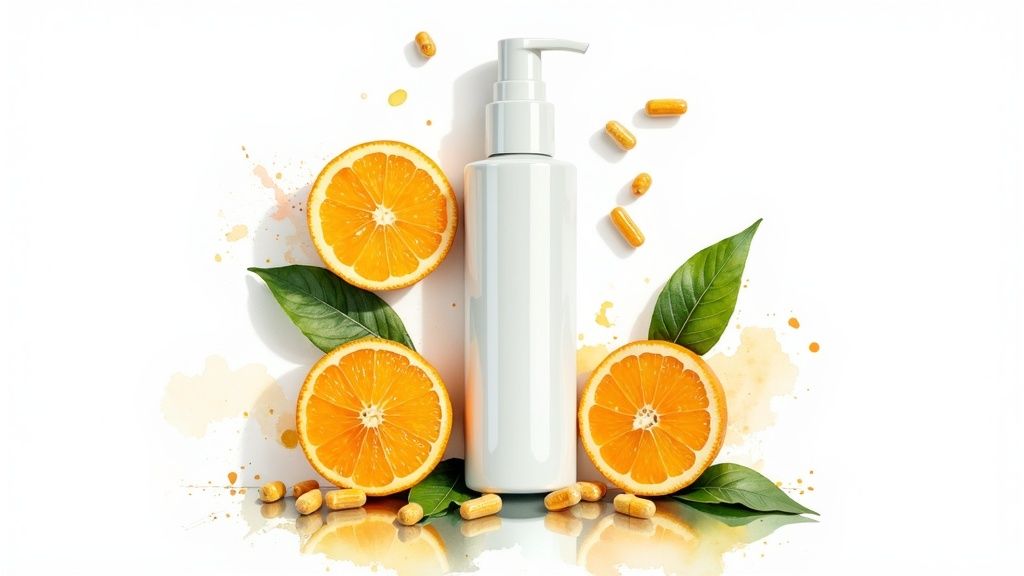
Ever notice how a single skincare ingredient can suddenly be everywhere? One minute it’s a niche term, and the next it’s all over your social media feeds and in every magazine. That’s usually not just hype; it’s because the ingredient actually works. The skincare world is driven by results, and when an active ingredient consistently delivers, people take notice.
Understanding what makes these ingredients trend is a great way to learn what are active ingredients in skincare in the first place. The most popular ones tend to be fantastic problem-solvers for the most common skin concerns, earning their fame by proving themselves time and time again.
The Reigning Champion: Collagen
Right now, one of the biggest names on everyone's lips is collagen. It's the main structural protein in our skin—the very scaffolding that keeps it firm, plump, and youthful. Its popularity isn't just a hunch; the data tells a powerful story.
Collagen has skyrocketed to become the most sought-after active ingredient, pulling in over 318,000 Google searches every single month. On TikTok, videos under its hashtag have amassed nearly 77 million views in the last year alone. This massive interest, detailed in a fascinating New Beauty report, shows just how focused people are on preserving elasticity and fighting off fine lines.
The appeal of collagen makes perfect sense. Our bodies produce less of it as we age, so skincare that helps support or stimulate what we're losing feels like a direct solution for maintaining a firm, resilient complexion.
Beyond Collagen: Other Trending Actives
While collagen is all about structure, other active ingredients have become superstars in their own right by targeting very specific issues. The conversation has moved beyond just one hero ingredient to a whole team of high-performance players.
Here are a few other actives currently leading the pack:
- Ceramides: Think of your skin cells as bricks; ceramides are the mortar holding them all together. These lipids are absolutely essential for a healthy skin barrier, locking moisture in and keeping irritants out. They’re a lifesaver for anyone with sensitive or compromised skin.
- Peptides: These are short chains of amino acids, which are the literal building blocks of proteins like collagen and elastin. Peptides act like little messengers, telling your skin to kickstart certain jobs, like producing more collagen or repairing damage. We dive much deeper in our guide on what peptides are in skincare.
- Salicylic Acid: This one is a true hero for anyone battling acne and clogged pores. As a beta-hydroxy acid (BHA), it's oil-soluble, which is its superpower. It can get deep down into your pores to dissolve the gunk—excess oil and dead skin cells—clearing breakouts from the inside out.
The rise of these ingredients shows a clear shift in how we approach skincare. People are no longer just looking for a "moisturizer" or an "acne cream." Instead, they're seeking out specific, proven actives known to solve their exact skin concerns.
This ingredient-first trend is incredibly empowering. When you understand what these popular actives do, you can stop guessing and start building a routine with the star players best suited to help you reach your skin goals.
Building Your Anti-Aging and Acne-Fighting Toolkit
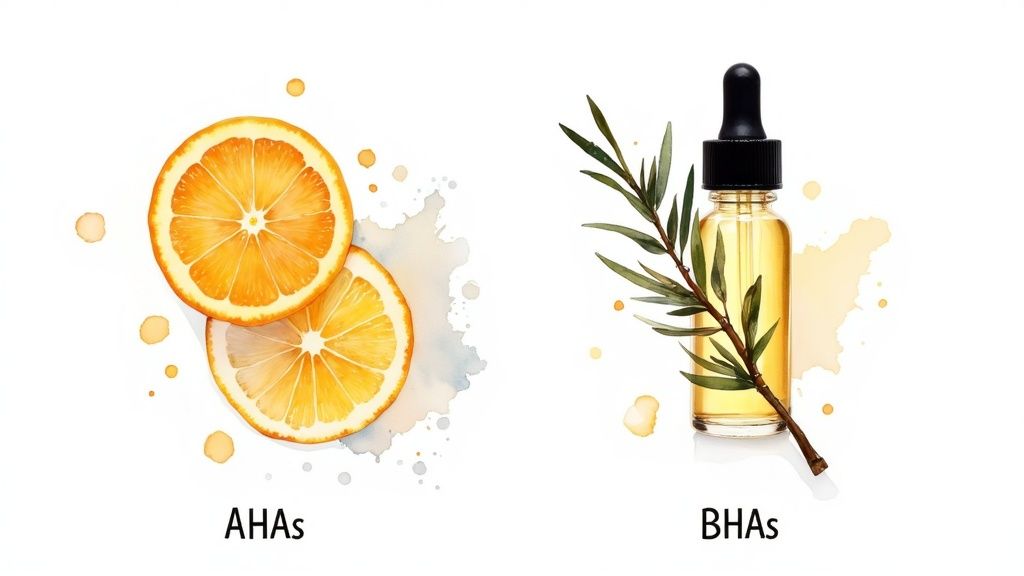
When you're dealing with stubborn issues like signs of aging or persistent acne, you need more than just a pretty bottle and a hopeful promise. You need a well-stocked toolkit filled with proven active ingredients. These are the workhorses of skincare, the specific compounds that dermatologists rely on to deliver real, noticeable changes.
Getting to know these key players is the first step toward building a routine that actually gets the job done.
The Gold Standard for Anti-Aging
When it comes to fighting fine lines and wrinkles, the conversation almost always begins with the undisputed heavy-hitter: the retinoid family. These Vitamin A derivatives are celebrated for their incredible ability to get skin cells to act younger. Think of them as a personal trainer for your skin, whipping lazy cells back into shape.
Retinoids work their magic by speeding up cell turnover, helping you shed the dull, damaged top layer of skin to reveal the fresher, smoother skin hiding underneath. Even better, they fire up your skin's collagen factories. Since collagen is the protein that keeps skin firm and bouncy, this dual action makes retinoids a powerhouse for softening wrinkles and improving overall texture.
Of course, no anti-aging strategy is complete without Vitamin C. This potent antioxidant is like a bodyguard for your skin, shielding it from the environmental damage (think pollution and UV rays) that accelerates aging. It’s also fantastic for brightening your complexion and fading dark spots, leaving you with a more even and radiant glow.
When you listen to dermatologists talk about effective skincare, the conversation always circles back to targeted active ingredients. For aging, retinoids are the gold standard, while for acne, a combination of exfoliants and antibacterial agents is strongly recommended. You can learn more about these powerful ingredients and discover what experts recommend on Skincare Network.
The Go-To Solutions for Acne and Blemishes
Just like with aging, clearing up acne calls for specific tools designed for the task. The game plan is to control oil, unclog pores, and kill bacteria—all without stripping your skin and causing more irritation. Two of the most reliable and accessible ingredients for this job are salicylic acid and benzoyl peroxide.
While they both fight breakouts, they attack the problem from completely different angles.
Salicylic Acid (A BHA): This one is an oil-soluble exfoliant. What that means is it can dive deep into your pores, dissolving the gunk and dead skin cells that cause clogs in the first place. It’s essentially a pipe cleaner for your pores, making it a fantastic choice for blackheads and whiteheads.
Benzoyl Peroxide: This ingredient is a pure antibacterial agent. It works by introducing oxygen into the pore, which effectively kills the acne-causing bacteria (P. acnes) living there. This makes it the go-to for tackling inflammatory acne—those red, angry pimples that are hard to ignore.
By understanding what these ingredients do and how they differ, you can start making smarter choices for your skin. Whether you want to age gracefully or finally get a handle on breakouts, choosing products with these dermatologist-backed actives is your best bet for seeing the results you’re after.
So, you understand that active ingredients are the heavy hitters in your skincare routine. Great. The next step is figuring out what they actually do. Think of it like building a team—each player has a specific role, and knowing those roles is key to a winning strategy.
When you start to classify actives by their function, the long, confusing ingredient list on the back of a bottle suddenly starts to make sense. You're no longer just buying a product based on hype; you're consciously choosing ingredients that will work together to get you the results you want.
The Protectors: Antioxidants
First up, let's talk about antioxidants. I like to think of them as your skin's personal security detail. Their main job is to defend your skin against nasty little molecules called free radicals, which are churned out by things we face every day, like UV rays and pollution.
Left unchecked, these free radicals wreak havoc, causing cellular damage that shows up as premature aging, stubborn dark spots, and a general lack of radiance. By neutralizing this threat, antioxidants keep your skin looking and feeling its best.
- Vitamin C (L-Ascorbic Acid): This is the A-lister of the antioxidant world. It not only protects your skin but also pulls double-duty by brightening your complexion and helping to build collagen, which keeps your skin firm.
- Niacinamide (Vitamin B3): A true multi-tasker, this one is fantastic for calming redness, strengthening your skin's natural barrier, and even helping to get oil production under control.
This visual guide breaks down which actives are best suited for different skin types, helping you pinpoint the right ingredient for your specific concerns.
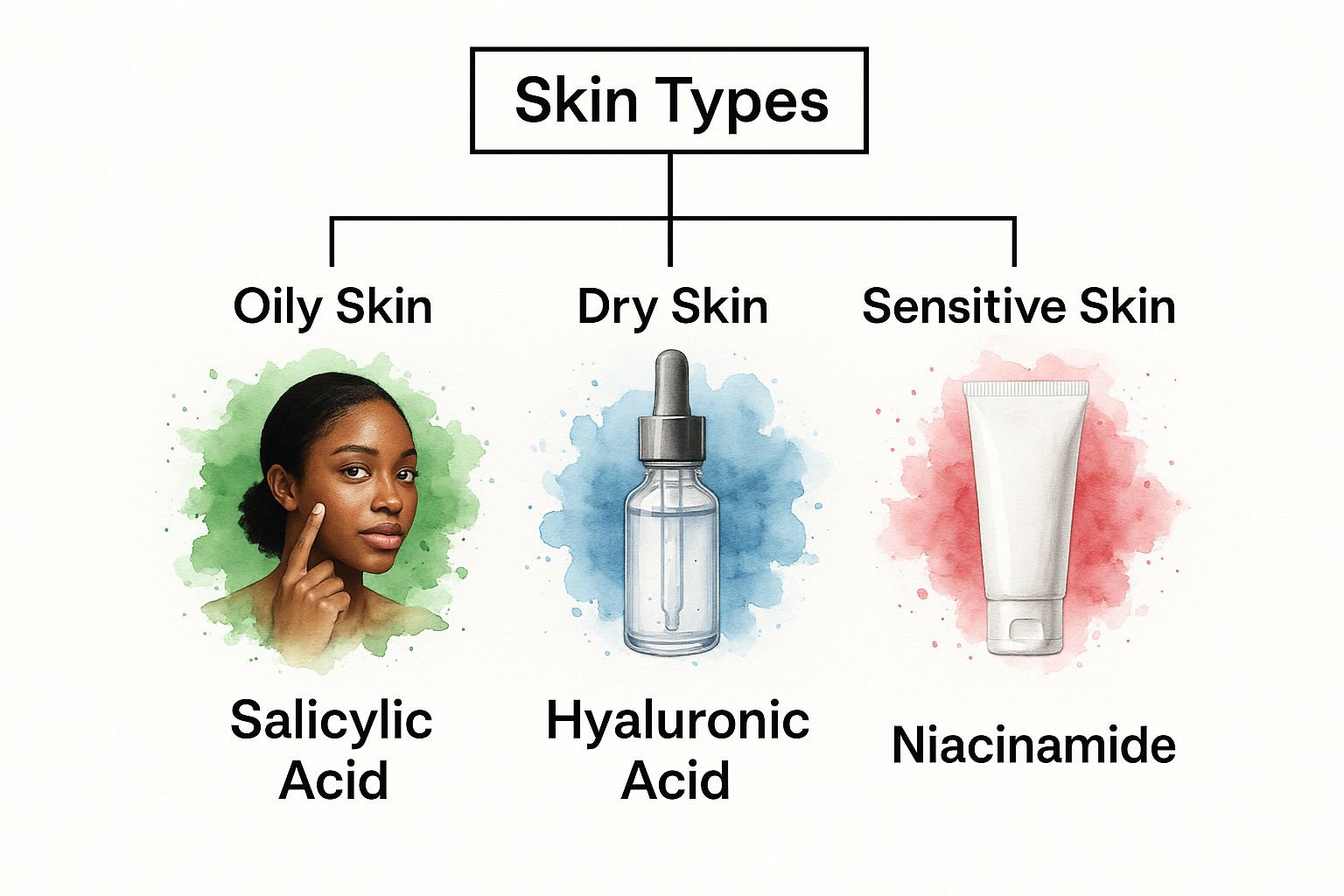
As you can see, matching an active to your skin type—like Salicylic Acid for oily skin or Hyaluronic Acid for dry skin—is the secret to getting targeted, effective results.
The Polishers: Exfoliants
Next on our roster are the exfoliants. Think of these as the polishers that buff your skin's surface to a shine. They work by dissolving the "glue" that holds dead skin cells together, allowing them to be swept away. What's left behind is brighter, smoother, and more even-toned skin.
This process is a game-changer for everything from dullness and rough patches to stubborn clogged pores and breakouts. Chemical exfoliants generally fall into two main camps, and each has its own specialty.
Key Takeaway: Choosing the right exfoliant comes down to your skin type and your goals. If you're dealing with surface issues like sun damage or dryness, AHAs are your friend. If clogged pores and oil are your main concerns, BHAs are the experts you need to call.
To help you decide which team to join, here’s a quick rundown of how they stack up.
AHA vs BHA Exfoliants: Which One Is for You?
Choosing between Alpha-Hydroxy Acids (AHAs) and Beta-Hydroxy Acids (BHAs) can feel confusing, but it’s actually pretty straightforward once you know their core differences. This table breaks it down so you can pick the right acid for your skin’s needs.
| Feature | AHAs (e.g., Glycolic Acid) | BHAs (e.g., Salicylic Acid) |
|---|---|---|
| Solubility | Water-soluble | Oil-soluble |
| Action | Works on the skin's surface | Penetrates deep into pores |
| Best For | Dry, sun-damaged, or mature skin | Oily, acne-prone, or congested skin |
| Primary Goal | Improving texture, tone, and hydration | Unclogging pores and reducing oil |
Ultimately, both are fantastic exfoliants. Your choice just depends on whether you need a surface-level polish (AHAs) or a deep-pore clean-out (BHAs).
The Communicators: Cell Regulators
Last but certainly not least, we have the cell regulators. I call these the "coaches" of your skincare routine. These powerhouse ingredients don't just work on the surface; they actually send messages to your skin cells, encouraging them to act younger and healthier.
This category includes some of the most respected and well-researched ingredients for making real, lasting changes to your skin.
- Retinoids (Vitamin A derivatives): These are the ultimate coaches. They tell your skin cells to speed up their turnover rate and kick collagen production into high gear. The result? Smoother texture, fewer wrinkles, and a more even complexion.
- Peptides: Think of these as tiny messengers. Peptides are short chains of amino acids that deliver specific instructions to your skin, like "build more collagen," "improve firmness," or "get to work repairing damage."
How to Safely Introduce Actives into Your Routine
It’s easy to get excited about powerful active ingredients, but they need to be treated with respect. One of the biggest mistakes I see people make is jumping in headfirst with high-strength formulas. This almost always backfires, leading to irritation, redness, and a damaged skin barrier. The goal is to get amazing results, not to send your skin into a tailspin.
The golden rule here is simple: go low and slow.
Think of it like easing into a new fitness routine. You wouldn't try to lift the heaviest weights on day one, right? You start light and build your strength over time. Skincare is no different. Begin with a low concentration of the active ingredient and use it just a few times a week—maybe every third night. This gives your skin a chance to get used to it. If everything looks good after a couple of weeks, you can slowly start using it more often.
The Importance of Patch Testing
Before you slather a new active all over your face, a patch test is an absolute must. This little step is your personal safety check, and it can save you from a world of hurt, like widespread irritation or a full-blown allergic reaction.
Here’s the right way to do it:
- Choose a discreet area: Dab a small amount of the product somewhere hidden, like just behind your ear or on the inside of your arm.
- Wait and observe: Let it sit for at least 24 hours, unless the product instructions say otherwise.
- Check for reactions: Keep an eye out for any redness, itching, burning, or little bumps. If your skin still looks calm and feels fine, you're probably in the clear.
Essential Rules for Using Potent Actives
Once you've done your patch test and are ready to go, there are a few ground rules that will keep your skin healthy and happy. Following them is critical if you want to understand what are active ingredients in skincare and actually get the benefits.
First, daily sunscreen is non-negotiable. Many of the most effective actives—especially retinoids and exfoliating acids like AHAs and BHAs—can make your skin more sensitive to the sun, a condition known as photosensitivity. If you're not using SPF 30 or higher every single day, you're not just risking sun damage; you're actively canceling out the good work your actives are doing.
You also need to know which ingredients shouldn't be mixed. Layering certain potent actives in the same routine is a recipe for over-exfoliation and a compromised skin barrier. For instance, never use retinol and a strong AHA/BHA exfoliant at the same time. Instead, use them on alternate nights to give your skin a break.
Figuring out how to layer and schedule your products is a huge part of building a successful routine. For a deeper dive into structuring your daily regimen, check out our complete guide on how to build a skincare routine. By respecting your skin and these simple safety measures, you can create a powerful routine that delivers real, visible change without the drama.
What's Next for Skincare Actives?
Let's be clear: the buzz around active ingredients isn't just a fleeting trend. It’s a seismic shift in how we think about and buy skincare, and it has some serious economic muscle behind it. Shoppers today are more informed than ever, and they’re demanding products packed with ingredients that are scientifically proven to work.
This isn’t just a small corner of the market anymore. This consumer-driven movement is completely changing the game. The intense focus on powerhouse compounds like retinoids, peptides, and various acids tells us that the question of what are active ingredients in skincare has moved from a niche topic to the absolute heart of a product's worth. Efficacy is the new standard, and it's not going anywhere.
The Booming Market for Ingredients That Work
The numbers don't lie—this shift is here to stay. The global market for skincare ingredients is gearing up for some massive growth, all thanks to people looking for real solutions to common concerns like aging and acne.
We're looking at a market projected to jump from $25.9 billion in 2025 all the way to $46.8 billion by 2035. This isn't just a blip; it's a clear, long-term trend toward science-backed skincare driven by hero ingredients like AHAs, BHAs, retinol, and Vitamin C.
That incredible growth isn't just an abstract figure. It represents millions of people actively searching for and spending their money on potent, effective skincare. If you're curious, you can discover more insights about this market trajectory and see what's really fueling the future of product formulation.
So, what's on the horizon? Innovation will continue to be a two-way street between scientific discovery and what you, the consumer, are asking for. As our knowledge of skin biology gets more sophisticated, we can expect to see new, even more effective active ingredients emerge, constantly redefining what’s possible in skincare.
Common Questions About Skincare Actives
Jumping into the world of skincare actives usually sparks a ton of questions. That’s a good thing. Getting the right answers is the first step toward building a routine that actually works for you without causing irritation.
Let's tackle a few of the most common questions I hear all the time.
How Long Does It Take for Actives to Work?
When it comes to skincare, patience truly is a virtue. While some ingredients give you a quick win—think hydrating or exfoliating actives that deliver an almost instant glow—the real power players need time to work their magic.
For ingredients that target change on a cellular level, like retinoids for smoothing fine lines or vitamin C for fading dark spots, you need to be consistent for at least 8-12 weeks. Think about it: you're asking your skin to make deep, structural improvements, and that just doesn't happen overnight.
Can I Use Multiple Active Ingredients Together?
You absolutely can, but you need a game plan. The easiest and safest approach is to separate them. For example, use your Vitamin C serum in the morning to protect your skin and apply your retinoid at night to repair it. Alternating days is another great strategy.
Whatever you do, don't layer potent actives like retinol and AHAs/BHAs at the same time. That's a fast track to over-exfoliation, irritation, and a compromised skin barrier.
What Is Skin Purging and Is It Normal?
Ah, the dreaded purge. It’s that temporary flare-up of breakouts that can happen when you start an active ingredient that speeds up skin cell turnover, like a retinoid or an exfoliating acid. Basically, it's pushing all the gunk that was already brewing under the surface up to the top all at once. It’s totally normal and should clear up within 4-6 weeks.
But if the breakouts and irritation stick around longer than that, it's likely a sign of a bad reaction, not purging. At that point, it’s time to stop the product and focus on how to calm irritated skin to get your barrier healthy again.
Ready to build a routine with confidence? At Olive Skin Therapy, we create customized treatments using the most effective active ingredients to help you achieve your skin goals. Book your personalized consultation today!
